Did you know the Brown Pelican can live up to 30 years1? It’s an iconic bird found on beaches. This bit of info is part of what makes our guide on Florida’s beach birds so great. It’s for anyone who loves to watch birds or enjoys the beauty of coastal birds.
Florida’s beaches are home to lots of bird types. You’ll see majestic seabirds, lively shorebirds, and elegant wading birds. So, get your binoculars ready! Let’s check out 20 beach bird types in sunny Florida. Our guide is great for folks into Florida wildlife, local birding, and taking photos of birds. It mixes fun facts with colorful pictures to show off the beauty of nature.
Key Takeaways
- Discover the diverse bird species found on the Florida coast.
- Learn about the lifespans and habitats of seabirds and shorebirds.
- Identify Florida birdwatching hotspots for an unforgettable experience.
- Understand the behavior and nesting patterns of coastal birds.
- Enjoy stunning bird photography to complement your birding adventure.
Introduction to Florida Beach Birds
Welcome to the wonderful world of Florida’s coast and its birds. Here, bird lovers can enjoy an amazing adventure. The Florida Gulf Coast is filled with places great for seeing birds, including some rare ones in Florida. This adventure awaits, whether you’re an expert birder or just curious.
Florida’s beach birds come in different kinds, like shorebirds, seabirds, and wading birds. In the shorebird group, we see species like the Sanderling and Wilson’s Plover. They show us different ways of eating and special traits to notice2. Seeing seabirds like Royal Terns and Black Skimmers is exciting too. They have unusual nesting habits and marks to identify them2. These birds turn the Florida Gulf Coast into a birdwatcher’s dream.
If you like wading birds, don’t miss the Great Blue Heron and American Oystercatcher. The Great Blue Heron is very tall and has a huge wingspan3. The American Oystercatcher is smaller but very good at catching food. Its looks and skills are impressive3. These spots let us watch these birds’ graceful moves and learn about saving their homes.
In South Florida, bird watchers also find birds from far away places. We see non-native birds like the Egyptian Goose and Monk Parakeet4. Sometimes, birds from the Bahamas, Europe, or Asia show up, making our birding experience richer4. A special bird, the Cape Sable race of Seaside Sparrow, is seen in the Everglades4. These sightings show how bird types on the Florida coast are always changing.
By bird watching in Florida, we help talk about and support bird conservation. Learning about bird travels or going to educational events matters2. We highlight the need to save these amazing beach birds and their precious homes by understanding and caring more about them.
Brown Pelican
The Brown Pelican is a majestic bird found on Florida beaches. It has a huge wingspan, up to 84 inches5. Bird watchers and photographers love these birds. They are known for how they feed and look.
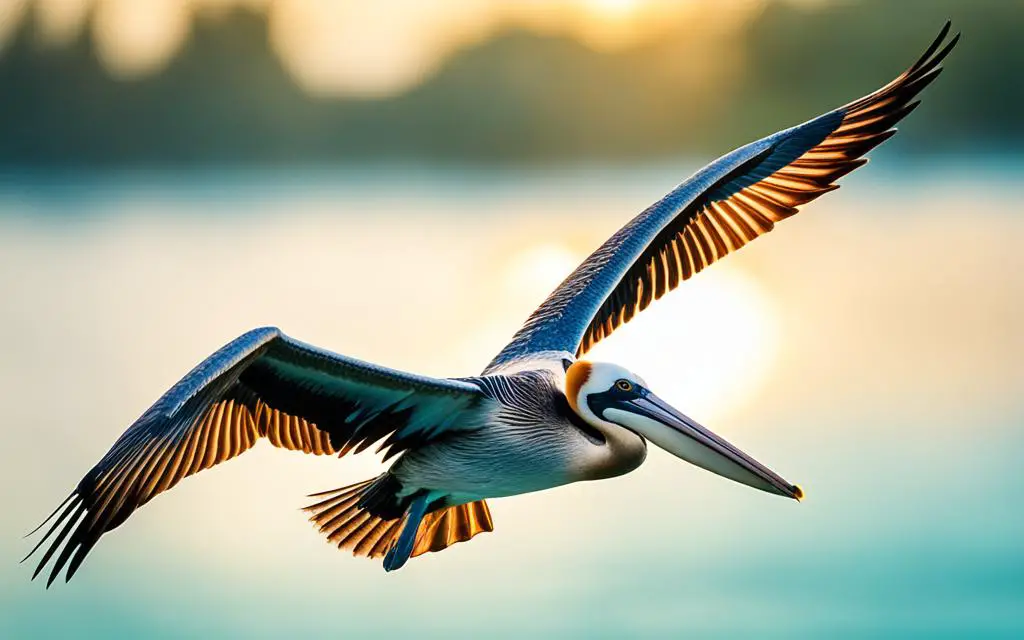
Characteristics and Behavior
Brown Pelicans are amazing divers. They dive from up to 50 feet to catch fish5. They fly together, low over the water, moving smoothly6. Adult pelicans are yellow and white with a dark brown color in breeding season. Young ones are gray-brown.6
They rest with heads on their shoulders. Or they preen in groups on sandbars6.
Habitat and Nesting
The Brown Pelican lives near coasts. They like beaches, sandbars, docks, and islands5. They nest in big groups, sometimes hundreds of pairs together5. They pick isolated islands to keep safe from predators.6
They feed their young soon after they hatch. The young can fly at 11-12 weeks old. They usually stop feeding them then6. The number of Brown Pelicans dropped in the 1960s and 1970s. This was because of DDD. But, thanks to efforts to save and protect them, their numbers are up again5.
Laughing Gull
The Laughing Gull is loved for its laugh-like call. It draws bird lovers in Florida. With a body of medium gray and a black hood in summer, it’s eye-catching. It has white arcs around its eyes and a reddish bill7. These birds are often seen on the Gulf and Atlantic beaches in summer. They nest in big groups, with thousands of birds8.
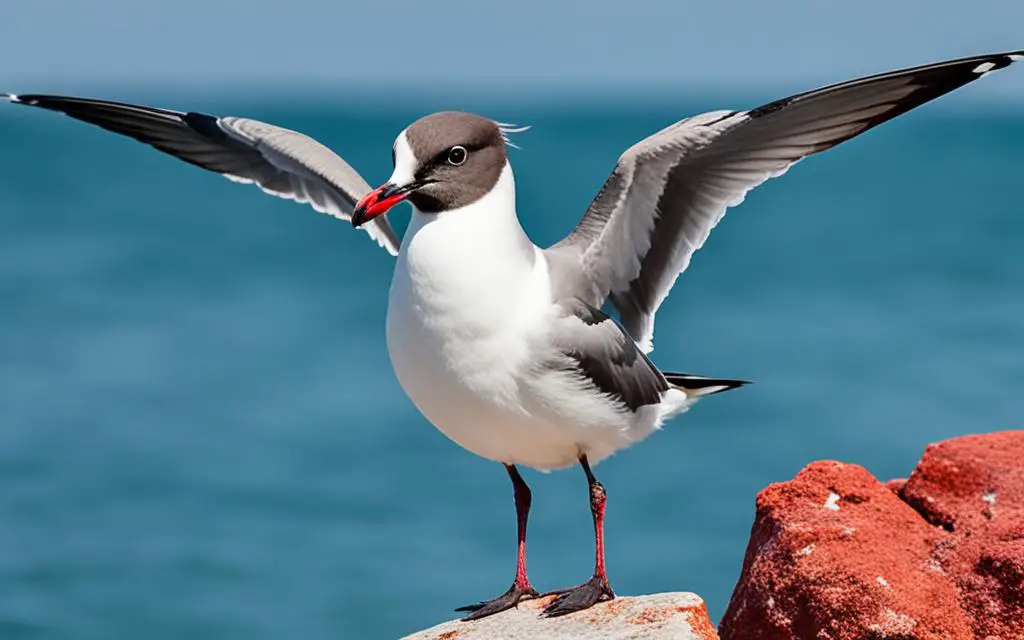
Unique Features
This gull is a bit smaller than Ring-billed Gulls and is about as big as a crow7. It takes 2-3 years to get its adult feathers7. They’re bold with people and hang out with other shorebirds9. These gulls make large, lively colonies on islands away from predators7.
Diet and Feeding
The Laughing Gull eats lots of different foods. They enjoy fish, bugs, and even trash or leftovers from fishing boats. They’re not shy about taking food from people7. They look for food along the shore and sometimes far away during mating season78. This gull does well even where humans have changed the environment. This has helped their numbers grow in many places8.
Royal Tern
The Royal Tern has regal silver-gray wings and a striking black crown. It stands out at Florida’s beaches. It’s bigger than a Ring-billed Gull but smaller than a Caspian Tern, similar in size to a crow10. With its black crest and bright orange bill, it catches the eye of bird lovers along the coast.
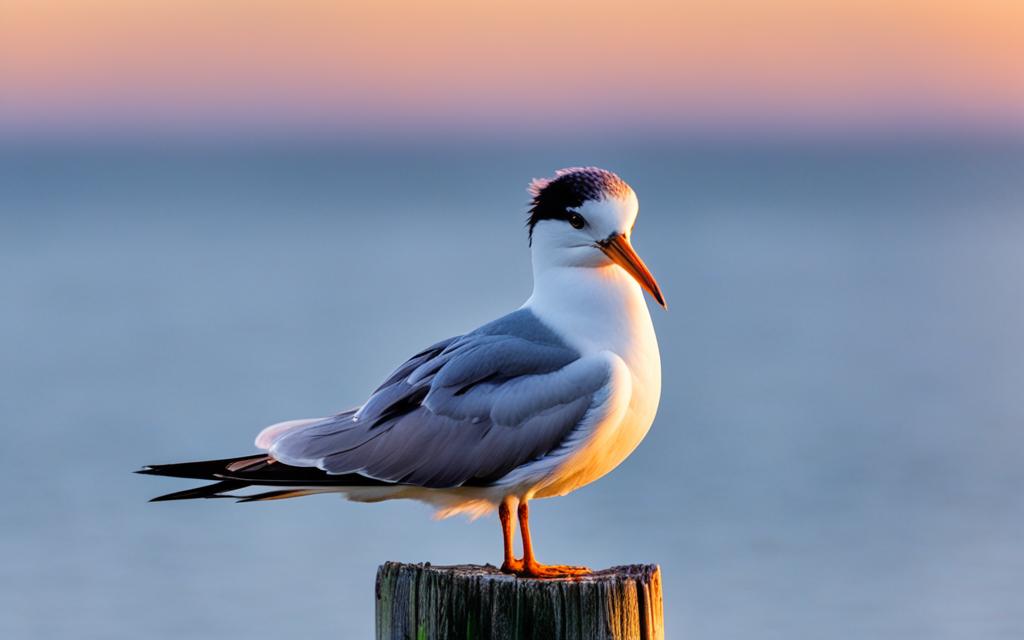
Royal Appearance
Breeding adults show off a shaggy black crown, looking majestic. Nonbreeding adults have a narrower band at the head’s back10. These unique features make it easy to spot. In 2019, many were seen in San Diego County, Southern California11. They’re a key species for beach bird photography.
Nesting and Courtship
Royal Terns nest tightly on sandy spots and islands by the coast10. They bounced back in the 20th century after their numbers dropped a lot12. The chicks join big groups a day after they hatch, staying together for days11.
The loss of nesting places still threatens them, highlighting the need to protect their homes12. The oldest Royal Tern was found in Belize in 2013, at over 30 years of age11. They hunt for food by diving from the air, showing off their skills to watchers10.
Black Skimmer
The black skimmer is a fascinating bird from Florida. It’s known for its eye-catching black and white colors. These birds are quite big, with a long wingspan and a unique beak13. They’re great at catching fish by skimming the water’s surface.
They usually have three to five eggs in a nest. Both mom and dad skimmers take turns warming the eggs for about 23-25 days13. After the babies hatch, their parents look after them. They help them until they can fly, which takes about 28-30 days13. Each parent takes a turn with the egg-warming job, keeping their little ones safe and cozy13.
In Florida, watching these birds is a treat, especially during their breeding season. You might see hundreds at a time, although not every nest will have eggs14. This scene is a dream for bird-lovers and those who love migratory animals.
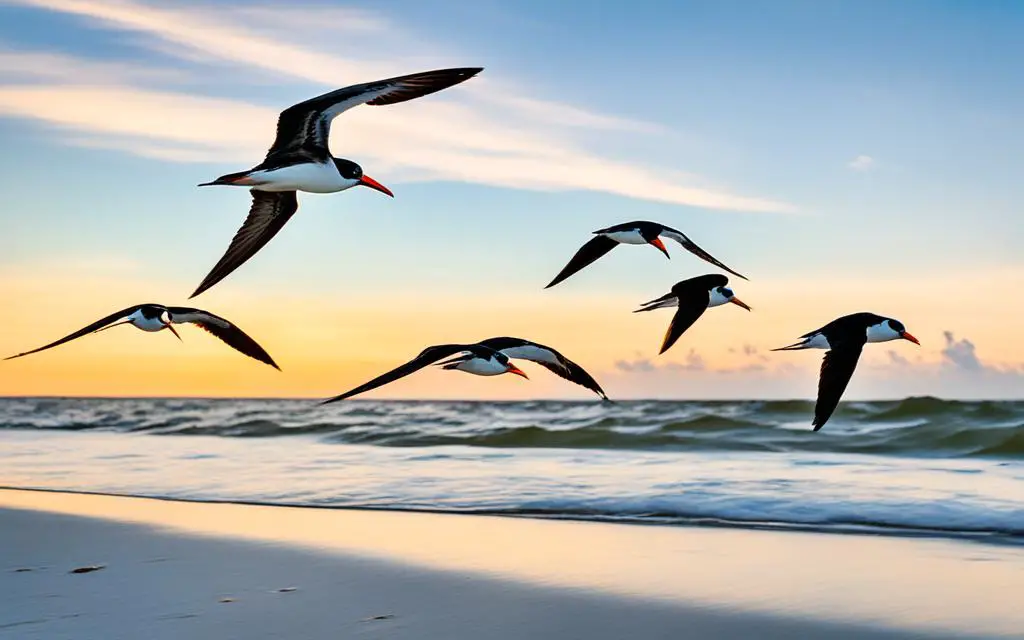
Their breeding lands stretch from Southern California down to Ecuador. Their mating dance is a must-see, adding wonder to Florida’s wildlife scene13.
The black skimmer is protected by law in the U.S. and Florida because it’s at risk13. Saving their homes is key to their survival. We must work to keep these unique birds around for future generations.
Sanderling
The Sanderling is known as the “wave chaser.” It’s a lively shorebird seen on Florida’s beaches. These birds are similar in size to a Dunlin but smaller than a Red Knot. They’re also bigger than a Least Sandpiper15.
Wave Chaser
The Sanderling wears light gray and white feathers without its breeding colors. Their legs and bill are black16. You can see them racing along the beaches, chasing waves to find food15. They use their long legs to keep up with waves, looking for snacks like crustaceans and mollusks15. This behavior is common for beachgoers in Florida to witness. Below is a picture of these lively birds.
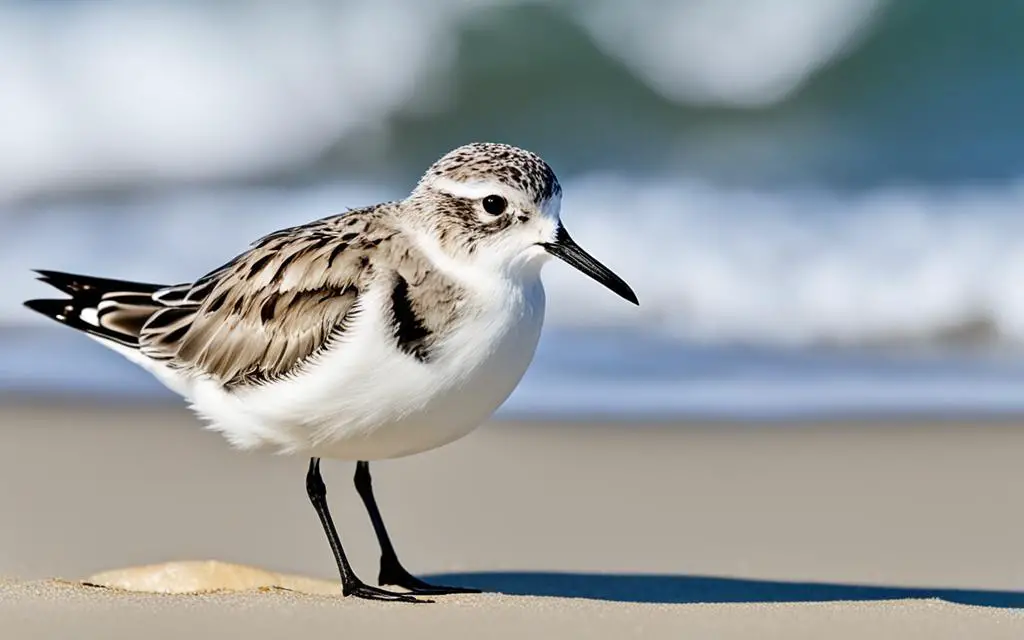
Migratory Patterns
Sanderlings breed in the High Arctic tundra and come to Florida in winter16. They are one of the most common shorebirds around the world in the off-season16. Their long travels show how tough and adaptable they are. However, Sanderlings have become less common. Surveys show they’ve declined by up to 80% in the Americas since the 1970s17. They are in danger due to habitat loss during their migration17. Audubon’s scientists are studying how climate change affects the Sanderling using climate models and bird studies17.
Willet
The Willet is a standout bird found in Florida. Its big size and long bill are eye-catching. You can see them on beaches, marshes, mudflats, and rocky areas18. They change colors from mottled brown in summer to gray in winter19.
Western Willets have lighter markings than Eastern ones. Juvenile birds also vary, with Western ones being grayer and bigger20. These birds like to be alone when they search for food like insects and mollusks20.
Willets are fun to watch, especially during their flight displays. They make a loud call and run with wings open when scared20. They eat different things depending on where they are. In freshwater, they eat beetles, fish, and spiders. In saltwater, they go for crabs, worms, and clams18.
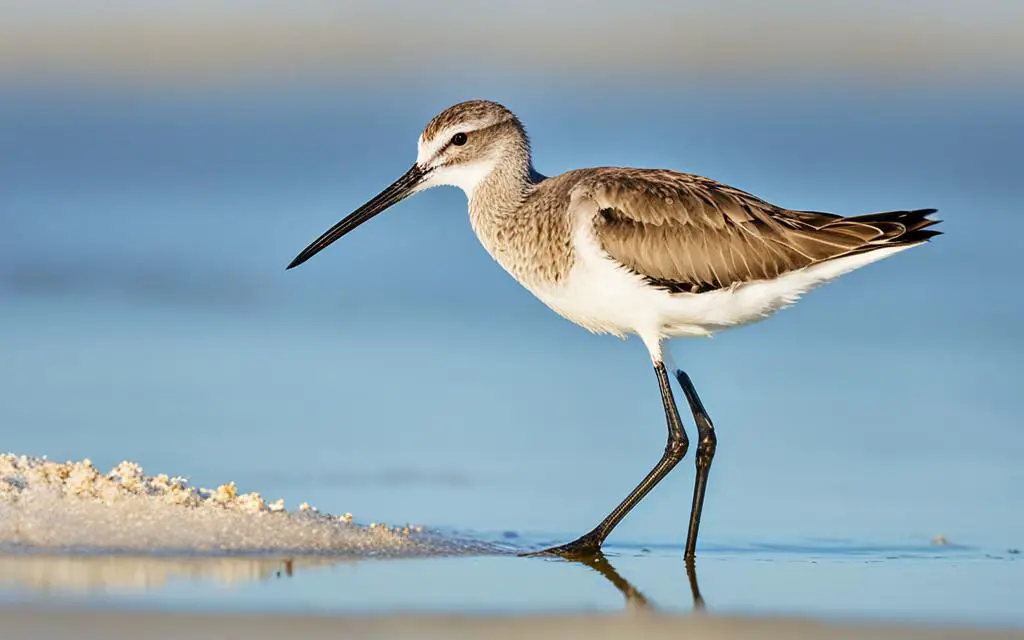
In the past, Willets were hunted a lot. The Migratory Bird Treaty Act helped them recover18. Yet, they are still watched closely to keep them safe. Even with these issues, Willets are common from New Jersey to Florida. This makes them a big part of our bird-watching19.
Wilson’s Plover
Wilson’s Plover stands out for bird lovers in Florida. It is bigger than the Semipalmated Plover but smaller than the Killdeer. Their unique build is easy to spot on the beach21.
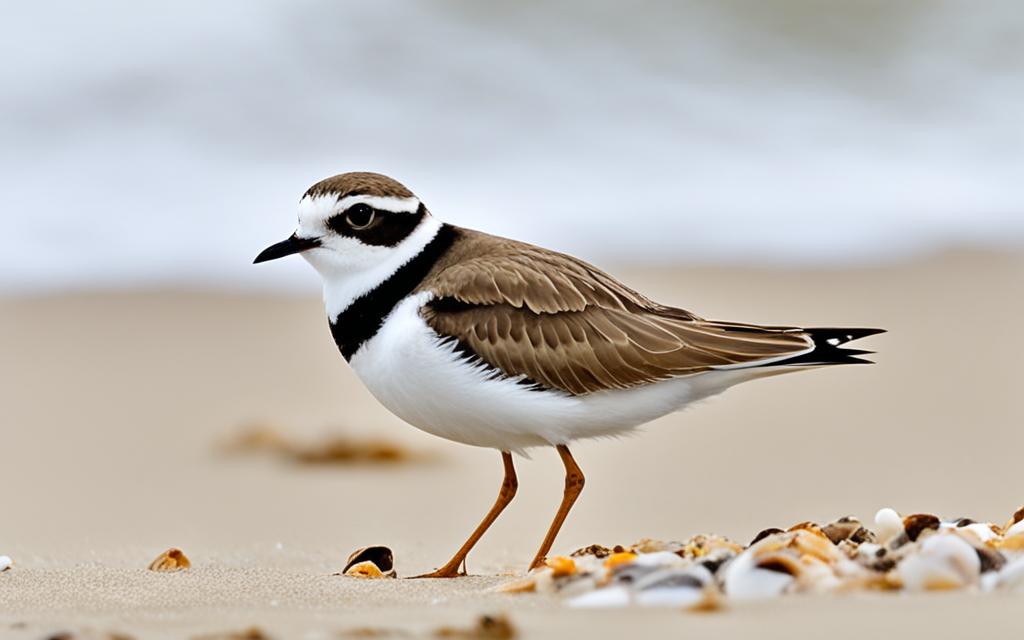
Physical Traits
The bird has sandy-brown feathers and a black chest band. This band helps it hide on the shore. Scientists found four types of Wilson’s Plover, all slightly different21. The subspecies wilsonia lives in the U.S., Caribbean, and Belize21.
Nesting Behavior
They nest on beaches, mudflats, and salt flats. They eat fiddler crabs mainly21. Wilson’s Plovers lay two or three speckled eggs22. These eggs hatch in about 30 days22.
During nesting season, you can spot them in pairs or small groups. They often stay at Gulf Islands National Seashore23. The young birds stay near their parents for around 28 days until they can fly22.
Interesting fact: Wilson’s Plovers pretend to be injured to protect their nests. These nesting and protective acts are key for their survival. Protecting their homes is crucial.
Wilson’s Plover adds to Florida’s coastal biodiversity. Outside of breeding season, they group together21. They eat clams, sand hoppers, seeds, and worms23. This bird is a treat for anyone who enjoys watching birds.
Least Tern
The tiny Least Tern is North America’s smallest tern and can be seen in Florida. It has a yellow bill, white forehead, and pointed wings24. Standing 8.3-9.1 inches tall, with a wingspan of 21-23 inches25, it excels at catching small fish for food25.
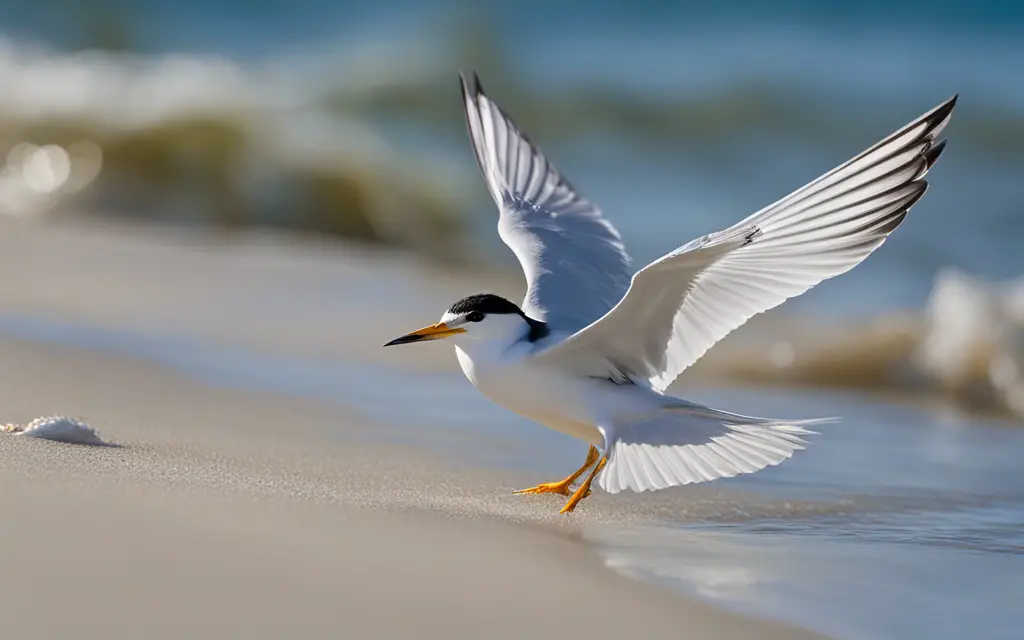
Small Stature
Adult Least Terns have sleek black, white, and gray feathers during breeding season26. Being the smallest tern allows them to fly agilely over water24. They are famous for their unique courtship where males give fish to females24.
Adaptation
Every spring, Least Terns come back to St. Augustine from further south26. They like open areas for their nesting, inviting others to join26. This way, they protect their 1 to 3 eggs and fend off predators together.
These terns are threatened by losing homes to buildings and people walking by25. But laws and bird rescuers work hard to keep them safe25. Especially through the U.S. Migratory Bird Treaty Act and the efforts of Audubon bird stewards25, who watch their nests closely26.
Spotted Sandpiper
The Spotted Sandpiper is a key part of the Florida beach bird world. It’s known for bobbing its tail up and down. This trait is unique and helps identify it easily27. This lively bird is smaller than a Killdeer but roughly the size of a robin. It always catches the eye of bird watchers27.
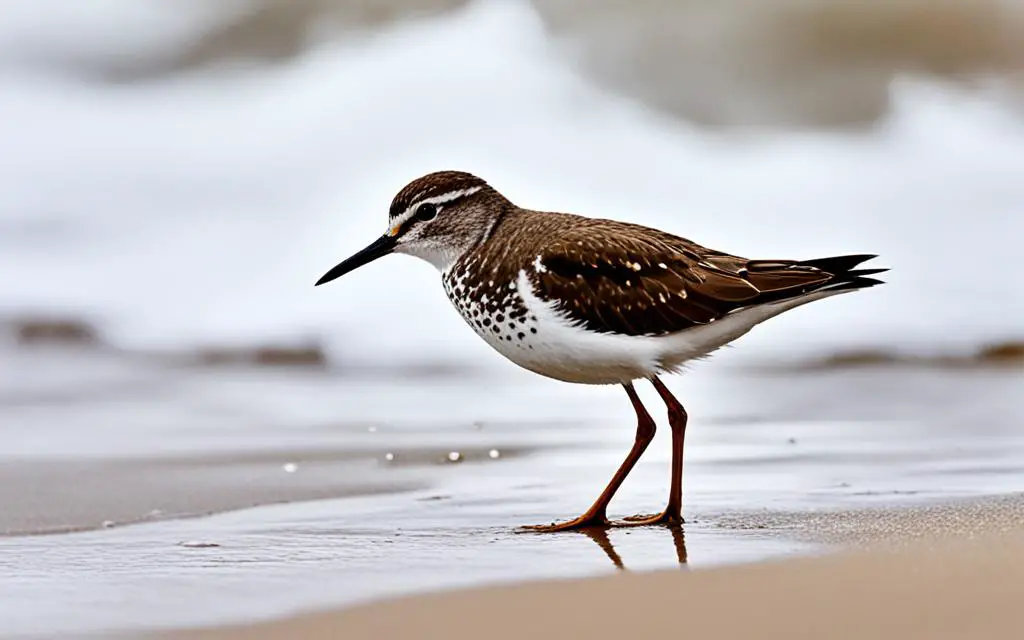
In the breeding season, this bird shows off dark spots against its white breast. It also sports an orange bill. These features set it apart from other beach birds27. The Spotted Sandpiper breeds more widely in North America than any other sandpiper28. It lives in many places, from streambanks to beaches. It’s often seen alone, hunting for food27. Seeing these birds is a joy for anyone who loves watching birds.
The female sandpipers reach the breeding areas before the males do. They even defend their territories. They practice polyandry, mating with several males, sometimes up to four, during breeding season28. For example, one female in Minnesota made five clutches for three males in just six weeks. This shows their unique way of reproducing28.
The spotted sandpiper shows grace and charm in its actions. From flying with quick wingbeats to walking with a teeter, it captivates us27. Its presence enhances beach bird watching and feeding activities in Florida. It’s always exciting to see them during our outings.
Ruddy Turnstone
The Ruddy Turnstone is a remarkable bird found on Florida’s beaches. It’s known for flipping over debris with its bill to find food like insects and crustaceans29. These birds come from the Arctic tundra to coasts around the world for the winter29. During this time, they like places with fresh water, mud, rocks, and sand30.
Foraging Technique
Ruddy Turnstones have a special way of finding food. They use their bills to move stones and shells, looking for sea creatures31. In the breeding season, they eat beetles, midges, spiders, and plants31. When not breeding, they eat almost anything, including garbage31. This makes them interesting to watch.
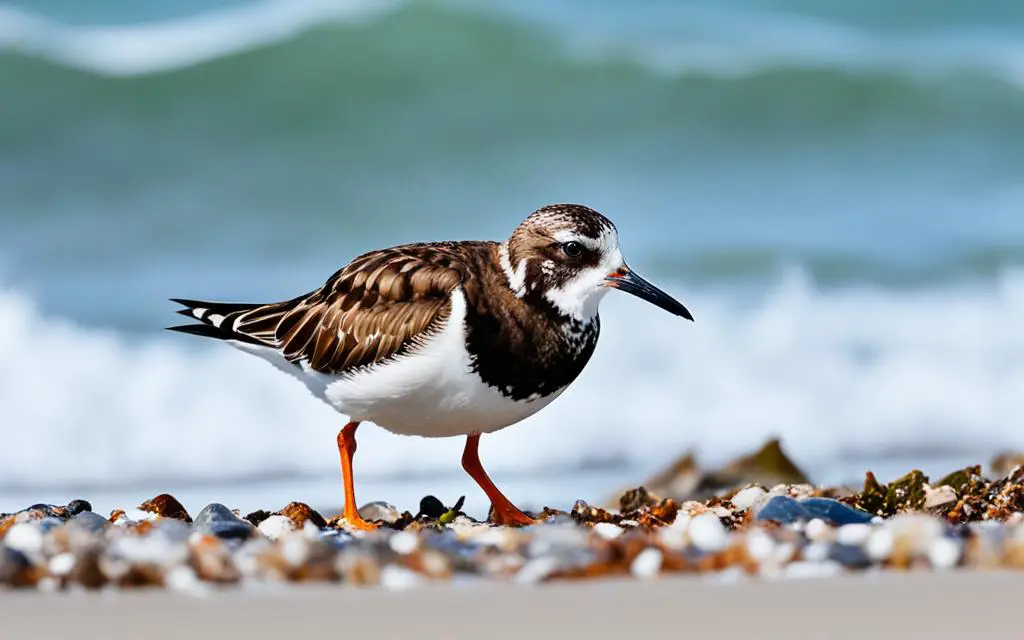
Physical Description
The Ruddy Turnstone has a look that catches your eye. With short orange legs and bright underparts, they stand out31. In winter, they turn brown but keep a brown chest patch30. When they fly, you can see white and black stripes30. Their breeding colors are bold, with red, white, and black feathers31.
Conclusion
Our trek through Florida shows the variety of beach birds. We see the beautiful Brown Pelican and tiny Least Tern. These birds show how nature adapts and thrives.
But, Florida’s beaches and birds face tough times. The BP oil spill in 2010 hurt many birds. About 800,000 birds died in that disaster32. The 2016 report says migratory shorebirds dropped by 70 percent since 1970. This is bad news for birds like Wilson’s Plover and Snowy Plover32.
Groups like ABC’s Gulf Program are fighting to help. They work in 21 spots in Florida and nearby states. Their job is to keep birds safe during breeding, study them, and teach people how to help32. They protect nests from harm, like cars and pets32.
To help these birds, we need to keep restoring their homes and fight climate change. When you see a bird, report it. Join in local efforts to save them. Let’s enjoy Florida’s birds and keep them safe for the future.
Source Links
- https://www.birdjoy.org/articles/florida-beach-birds/
- https://fl.audubon.org/sites/default/files/audubon_beachdocentmanual_april2016.pdf
- https://oceanconservancy.org/blog/2022/07/07/sea-birds-florida/
- https://tropicalaudubon.org/birds-of-south-florida
- https://myfwc.com/wildlifehabitats/profiles/birds/shorebirdsseabirds/brown-pelican/
- https://www.allaboutbirds.org/guide/Brown_Pelican/id
- https://www.allaboutbirds.org/guide/Laughing_Gull/id
- https://abcbirds.org/bird/laughing-gull/
- https://www.visitflorida.com/things-to-do/outdoors-and-adventure/wildlife/birding/
- https://www.allaboutbirds.org/guide/Royal_Tern/id
- https://www.allaboutbirds.org/guide/Royal_Tern/overview
- https://www.audubon.org/field-guide/bird/royal-tern
- https://myfwc.com/wildlifehabitats/profiles/birds/shorebirdsseabirds/black-skimmer/
- https://www.stpetebeach.org/602/Black-Skimmers
- https://www.allaboutbirds.org/guide/Sanderling/id
- https://www.allaboutbirds.org/guide/Sanderling/overview
- https://www.audubon.org/field-guide/bird/sanderling
- https://www.allaboutbirds.org/guide/Willet/lifehistory
- https://incidentalnaturalist.com/2017/05/03/the-wading-willet/
- https://www.allaboutbirds.org/guide/Willet/id
- https://www.allaboutbirds.org/guide/Wilsons_Plover/id
- https://fl.audubon.org/news/wheres-wilson
- https://www.nps.gov/guis/learn/nature/wilsonsplovers.htm
- https://www.allaboutbirds.org/guide/Least_Tern/id
- https://myfwc.com/wildlifehabitats/profiles/birds/shorebirdsseabirds/least-tern/
- https://fl.audubon.org/news/least-tern-fascinating-bird-needs-our-help
- https://www.allaboutbirds.org/guide/Spotted_Sandpiper/id
- https://www.allaboutbirds.org/guide/Spotted_Sandpiper/overview
- https://www.allaboutbirds.org/guide/Ruddy_Turnstone/overview
- https://www.allaboutbirds.org/guide/Ruddy_Turnstone/id
- https://www.onthewingphotography.com/wings/2010/10/31/shorebirds-of-fort-de-soto-ruddy-turnstones/
- https://abcbirds.org/saving-gulf-coast-shorebirds-one-beach-at-a-time/

My name is Shane Warren, the author behind Your Bird Buddy – your ultimate guide to the wonderful world of birds! Unleash your inner avian explorer as we delve into a vibrant library of knowledge dedicated to all things feathered. From learning about diverse bird species from across the globe to understanding their captivating habitats and behaviors, I’m here to fuel your passion for these magnificent creatures. Not only that, but I also provide valuable insights on being a responsible and informed pet bird owner. Join our vibrant community and let’s celebrate the feathered wonders of the world together – one chirp at a time. And be sure to join our Your Bird Buddy Community over on Facebook!

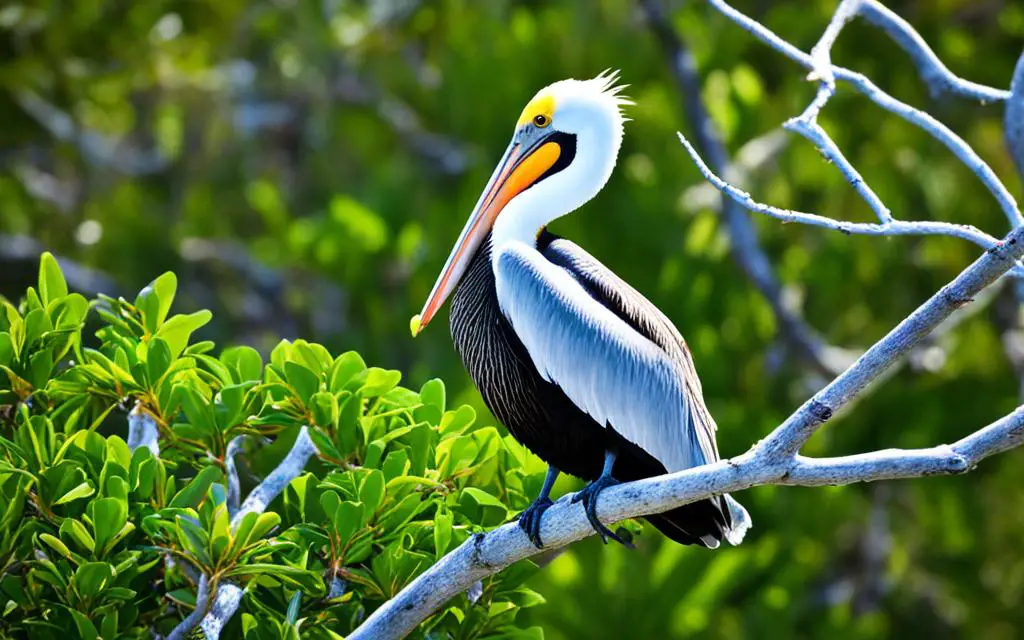
Comments are closed